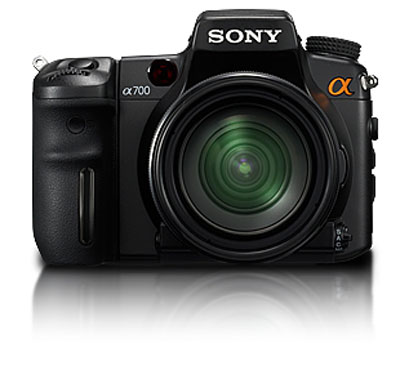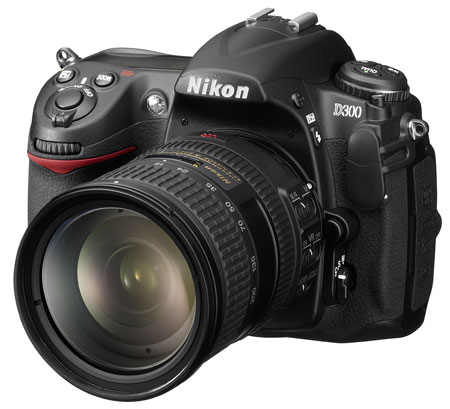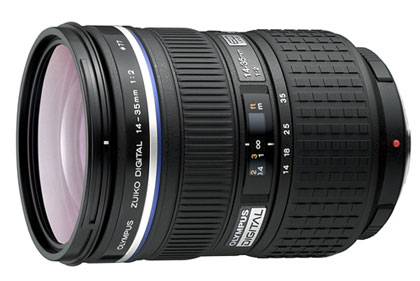Digital Camera Buyers' Guide - Year of the SLR
by Wesley Fink on November 23, 2007 6:00 AM EST- Posted in
- Digital Camera
Prosumer SLRs
It seems everyone is introducing new prosumer models. Understanding what's hot in this market of hard-to-please photography buffs will help you know what to look for in an entry-level camera. If you're in the market for one of these advanced amateur DSLRs, you may want to pay closer attention.

Sony started this prosumer round, just as they started the 10 megapixel (MP) round last year. The new top-of-the-line Sony is now their $1400 A700. Those who doubted that Sony was in the digital SLR market to win were greeted with a slick, stylish, and very fast 12.2MP DSLR with image stabilization, auto dust cleaning, a 3" hi-res LCD, 5.0FPS shooting, and new Sony brand lenses. Conspicuously absent is Live View, a feature pioneered by Olympus on DSLR cameras that allows the user to see through the lens on the LCD. This is standard fare on a point-and-shoot, but difficult to do with the "through-the-lens" optical viewing that is a feature of SLR technology.

Because they are so huge and influential in the photo market, Canon prosumer models receive lots of scrutiny. The new Canon model is the 40D, which continues the 20D/30D models that have defined the Canon prosumer DSLR. The 30D is 8MP and the 40D raises that to 10MP. Many expected an even higher-resolution 40D, but instead the 40D features the same 10MP resolution seen in the entry-level Canon XTi for the past year. New for the $1300 40D is much faster auto-focus, a 3" LCD replacing the 2.5", dust cleaning on startup, dust sealing, and Live View - a first for Canon. There are many other improvements, but they refine existing features of the Canon line.

Nikon announced - but has not shipped - the new D300, which is an update to the D200. The D200 got lost in the wake of the entry-level D80 last year. Nikon uses Sony sensors with their own electronics, and it appears the new D300 uses the same Sony 12.2MP CMOS sensor with on-sensor noise reduction found in the Sony A700. The D300 will launch at a street price of about $1800. The D300 also features a 3" hi-res LCD, very fast autofocus, Nikon's first auto sensor-cleaning system, 6FPS shooting, dust/splash sealing, and Live View.

Olympus has come to life recently, just when many had all but given up on them. Always the innovator, Olympus pioneered auto dust cleaning and Live View on digital SLR cameras based on their "digital-only" 4/3 standard. However, the Olympus 4/3 system was getting very long in the tooth, with a 5.5MP pro model E-1 introduced in 2003. Olympus has just started shipping their new E-3 flagship, which thoroughly updates the Olympus system.
Olympus says the E-3 is their pro model, and it features dust and splash sealing for both the E-3 body and pro lenses. The E-3 also introduces the first new AF module for Olympus in many years. The new AF, which was long overdue, features 11 cross-type sensors, each on two planes, for a total of 44 segments. According to Olympus, the result is the fastest auto focusing SLR you can buy when used with their new SWD (Sonic Wave Drive) lenses, such as their new 12-60mm f2.8-4.0 (24mm-120mm equivalent). The street price of $1699 is much less expensive that the $5000+ entry price for Nikon and Canon pro models. Many, however, feel the real competition for the E-3 is the "prosumer" Nikon D300 and Canon 40D.
The E-3 is also the first Olympus pro model to feature built-in flash, and it's dust and splash sealed. Auto sensor cleaning is a feature, image stabilization is built in and works with all lenses, and the latest incarnation of Live View with a fold out articulating LCD screen is featured. The LCD screen is 2.5", and not the 3" screen of competing models, but competing models don't have a flip-out LCD. Resolution is 10MP, but the E-3 supports ISO-3200 and it is definitely the low-noise camera many didn't think was possible with the smaller 4/3 sensor.
Canon ditched their FD breech mount years ago when they first introduced the EOS autofocus system. That risky move has paid off handsomely for Canon with their current line of all electronic, lens-motor driven lenses. Olympus took a similar tact by ditching their OM mount for an all-electronic mount for digital cameras. However, Olympus didn't have the influence of a Canon when they championed a smaller 4/3 standard sensor and claimed that lenses needed different designs for best digital performance. This was regarded by most of us as marketing-speak, but recent reviews of Olympus glass are showing their 4/3 lens designs - even their cheap kit lenses - do have less light fall-off and are generally sharper in digital photography than competing systems using APS-C or 35mm lenses.

The bottom line is the E-3 and recent Olympus lenses like the pro 14-35 f2.0 zoom (equivalent 28-70mm) and the tiny, cheap, but excellent quality 40-150mm (equivalent 80-300) f4.0-5.6 kit lens may finally gain Olympus the respect in the digital SLR market that has eluded them up to now.










74 Comments
View All Comments
StephenP - Friday, November 23, 2007 - link
I forgot to say nice article :). Just a little too much focus on sensor mega pixels, anyone into photography knows that stuffing a camera with mega pixels isn't enough to make a good camera. The new 400D has "only" 10mp of resolution but, that provides for A3 or even A2 prints. Does one really need more? ok, you can crop more, sure but what is the real difference between 3000x4000 pixels (12mp) and 2800x3700 (10mp), 2-300 pixels isn't a very impressive extra crop. I'll take better high ISO performance to more MPs anyday.AsicsNow - Friday, November 23, 2007 - link
Yeah, the unless you are using a full frame camera, the lens itself is limiting the effective resolution to not much more than 1OMP anyways. If you want a higher resolution without just adding garbage pixels that will end up as adding more noise(look at so many point and shoots that have these issues these days) you have to goto a larger format sensor, aka. 4" x 5" which is WAY beyond the scope of any non-professional photographer unless if you're a rich prick yuppie :)The D40 is a steal though if you can live without manual focus, and I can't wait for the 18-55 VR to come out. (Though I wish I could afford a 12-24 instead hehe)
Lord 666 - Friday, November 23, 2007 - link
Wes, while it might be under NDA, what is the time frame for the Nikon 18-55 VR? Real soon, Q1, Q2 kind of thing? If they are coming out with it, very surprised they didn't launch for this holiday season.PS - You should do these updates more often. Way back a while ago you started writing the DSLR column, but didn't continue. Keep it up ;)
Wesley Fink - Saturday, November 24, 2007 - link
The Nikon Press announcement for the 18-55mm VR was 11/19/2007. The street price for the new lens is $199 and it is said to be available now.Camaban - Friday, November 23, 2007 - link
Hmm, so the Olympus E-510 is something like $570-$670, while on Amazon UK, it's £618.....Ya know, that's like the equivilent of $1250 or something.
Ridiculous.....
makulit - Friday, November 23, 2007 - link
Pentax? Ever heard of them???mcnabney - Friday, November 23, 2007 - link
No kidding!!!!!!11 months ago there was a review, RIGHT HERE, that identified the K10D as one of the best choices. It is barely mentioned here, even though it is being written elsewhere as a camera of the year due to the turnaround it has caused.
Why choose Pentax?
Built-in 3 axis image stabilization which works on ALL lenses.
Almost every Pentax and Pentax-compatible lens that has ever been made works just fine on this body
Dust and water sealed body - you have to spend double elsewhere to get this
Great prices and growing library of high quality and reasonably priced lenses
takumsawsherman - Friday, November 23, 2007 - link
This is an excellent point. Pentax has actually had great, low-priced cameras from the film days. The K1000 was an awesome camera on the cheap.Minolta Maxxum cameras (now Sony) was also a less expensive, but excellent camera. I have owned the Maxxum 7000, 600si and Minolta Maxxum Alpha 707 (my current camera). Although the 7000s were more durable, these cameras have excellent autofocus (they have almost always more fast and accurate than Canon/Nikon), great lenses, and are loaded with features. I am still looking for a cheap Maxxum 9 now that film is less popular.
If I were to get a new body, I would get a Sony A700, since my lenses will work, and be image stabilized (ever look at the cost of Canon's IS lenses? Ouch!). However, if I were buying a completely new system, I would be seriously tempted by Pentax, as I trust Sony less than I trusted Minolta :).
All of my pro photo customers are using Canon, even the Nikon fans. Anything big and they use a Hasselblad-Leaf system. I've heard lots of complaints about the D40x shooting JPEG poorly. Apparently to get good results one must shoot in RAW. I doubt any will switch to Sony or Pentax. Not because they aren't as good (and I think that the Sony is as good). But Minolta and Pentax have always been considered "second tier" amongst that crowd, and I just don't see that changing, whatever the merits.
Regarding lack of Minolta lenses, I have not noticed any difficulty getting good, reasonably-priced lenses, and there is a large used market in the form of eBay and B&H if one prefers something not-new.
Frumious1 - Friday, November 23, 2007 - link
I'm not sure how they "missed" the Pentax K10D....Page 4: "One of the amazing price drops of this season is the Pentax K10D, which can be found with the kit lens for around $750, or as a body alone for as little as $650. The Pentax K10D is the only camera in this group that has full dust and moisture sealing. It also features body-integral image stabilization, auto sensor cleaning, and an 11-point focusing system."
Page 5: "Alternative: If low-light performance is a major concern, then you would do well to choose the Sony A100 kit with the 18-70mm kit lens. For a bit more money, the Pentax K10D gives you a great 11-point focus module, all the other features, and pro-type dust and moisture sealing."
takumsawsherman - Saturday, November 24, 2007 - link
Maybe you missed the word "barely". I read the review. I know what it said, and agreed with the OP that Pentax got "barely" a mention, where it really produces because it has to in order to compete against the name power of Nikon and Canon.